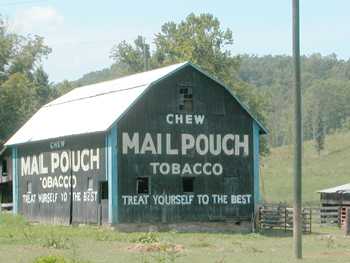Harley Warrick
| Harley E. Warrick | |
|---|---|
 Mail Pouch barn painting | |
| Born |
October 5, 1924 Londonderry, Ohio |
| Died |
November 24, 2000 (aged 76) Belmont, Ohio |
| Occupation | Barn painter |
| Known for | Mail Pouch Tobacco Barn sign painting |
Harley E. Warrick (October 5, 1924 – November 24, 2000), was an American barn painter, best known for his work painting Mail Pouch tobacco advertising on barns across 13 states in the American Midwest and Appalachian states. Over his 55 year career, Warrick painted or retouched over 20,000 Mail Pouch signs.[1] When he retired, he was the last of the Mail Pouch sign painters in America.[2][3] The Mail Pouch signs have become iconic and some of Harley Warrick's work has been exhibited by the Smithsonian Institution.[4][5] Though he was not the first or the only Mail Pouch barn painter, he was the most prolific and famous.[6]
Early life
Warrick was born and raised in Londonderry, Ohio, where his family had a dairy farm. When he returned from service in World War II in 1946, he began painting his family's dairy barn with a team of Mail Pouch sign painters; they suggested he join them.[1] Upon reflection, Warrick decided that it would be better than milking his family's Jersey cows each day so he began painting with the team. Having just returned from the Army, Warrick had no other clothes and so he painted barns for the first week in his uniform.[7] It turned out to be the only job he would ever have.[4]
Mail Pouch career
| Wikimedia Commons has media related to Mail Pouch Tobacco Barns. |
Warrick and a partner traveled from town to town, sometimes sleeping in the back of a pickup truck or cheap motel. They would often be on the road for months at a time. With the partner painting the black background and Warrick painting the letters, they were able to paint two barns a day, taking about six hours per barn.[1][3] Warrick painted signs in Ohio, Pennsylvania, West Virginia, Maryland, Kentucky, Indiana, New York, Illinois, and Michigan.[8]
Warrick used no template or tools, painting the sides of barns entirely by eye.[8] He would start with the letter 'E' in 'CHEW' and then add the 'W' and then 'CH'.[4] He once said that he always started with the 'H', 'E', and 'W' as those represented his initials.[9]
Harley would sometimes deliberately misspell words to see how many phone calls the tobacco company would get about it.[10] He had said that once in a while he'd put three 'C's in 'TOBACCO' just to see if anyone noticed.[8]
The Highway Beautification Act of 1965, which prohibited advertising billboards within 660 feet (200 m) of an interstate highway, effectively ended the era of painting the sides of barns for advertising. Though nearly all other sign painters went out of business, Warrick continued to work for the Swisher International Group, owner of Mail Pouch Tobacco, painting barns along lesser roads and highways until his retirement in 1991.[5] When the Mail Pouch signs were designated as National Landmarks, they were exempted from regulations against tobacco advertising and Warrick continued to paint.[3] Not until Warrick's retirement did Mail Pouch suspend the barn painting advertising campaign.[11]
Warrick is cited as an influence on Scott Hagan, who is noted for his barn paintings for the Ohio Bicentennial.[12]
Personal life
Warrick was married twice and had four children. The travel and time away from home put a strain on his first marriage and his wife gave him an ultimatum: either choose her or the job. Warrick said that he must have liked the job better than he liked her, and they parted.[4] After remarrying, he went out only for a week at a time.[8]
When he retired, Warrick continued to paint Mail Pouch signs on the sides of barn-shaped bird feeders and mailboxes that he would make and sell in his workshop in Belmont, Ohio.[5] He died in a Wheeling, West Virginia, hospital in November 2000 of an aneurysm.[1]
References
- ↑ 1.0 1.1 1.2 1.3 "Harley Warrick; the Barns of America Bear his Mark". The Los Angeles Times. November 29, 2000. Retrieved 23 March 2011.
- ↑ "Harley E. Warrick (1924-2000)". Belmont in Belmont County, Ohio - The American Midwest (Great Lakes). The Historical Marker Database. Retrieved 23 March 2011.
- ↑ 3.0 3.1 3.2 Nussbaum, Nancy. "The Passing of a Legend: Harley Warrick, The Mail Pouch Sign Painter". The Barn Journal. The Barn Journal. Retrieved 23 March 2011.
- ↑ 4.0 4.1 4.2 4.3 "Harley Warrick, Painter of Signs". GoodBye! The Journal of Contemporary Obituaries. GoodByemag.com. Retrieved 24 March 2011.
- ↑ 5.0 5.1 5.2 Witt, Linda (October 24, 1983). "Sign Painter Harvey Warrick Thrives as An American Primitive". People Magazine 20 (17): 98–99. Retrieved 24 March 2011.
- ↑ Nordin, Dennis Sven; Scott, Roy Vernon (2005). From prairie farmer to entrepreneur: the transformation of midwestern agriculture. Indiana University Press. pp. 6–7. ISBN 978-0-253-34571-4.
- ↑ Greene, Bob (July 16, 1997). "The Bottom Line: Some Riches Can't Be Counted". The Chicago Tribune. Retrieved March 26, 2011.
- ↑ 8.0 8.1 8.2 8.3 Lilliefors, Jim (1993). Highway 50: ain't that America. Fulcrum Publishing. pp. 66–71. ISBN 978-1-55591-073-0.
- ↑ Butterbaugh, Kelly Ann. "America's Unicorns: Mail Pouch Barns". Iowa Barn Journal.
- ↑ Curtis-Dougherty, Martha (2007). Thirty-Six Years Later. . . Double Edge Press. pp. 73–74. ISBN 978-0-9774452-7-1.
- ↑ "The History of the Mail Pouch Barn". Ohio Barn Survey. Ohio Barn Survey. Retrieved 5 April 2011.
- ↑ Hagan, Scott (December 5, 2000). Barn Painting. Interview with Noah Adams. All Things Considered. NPR. Retrieved January 1, 2015.
Further reading
- Warrick, Harley (2004). The Barn Painter. Roger Warrick, illustrator. ST Media Group International. ISBN 978-0-944094-54-9.